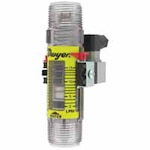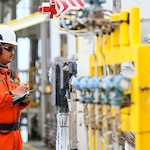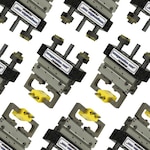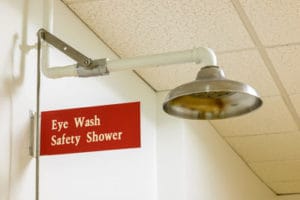
In any environment where hazardous chemicals are used, knowing the exact location of the emergency safety shower and eyewash station can make the difference between a minor incident and a serious injury. These emergency fixtures are essential in laboratories, manufacturing plants, or really any other environment where exposure to corrosive or toxic materials is possible.
An emergency safety shower is designed to quickly rinse hazardous substances that come into contact with the skin, hair, or clothing. Because the water pressure and flow rate are typically too high for delicate tissue, a separate eyewash station is required to safely flush contaminants from the eyes. Together, these systems provide immediate first aid that can significantly reduce the severity of chemical injuries.
Why Proper Water Pressure Is Critical
When exposure to hazardous material occurs, the window for a safe response is extremely narrow. Safety showers and eyewash stations are only effective if they deliver the correct volume and velocity of flushing fluid, and for the right duration.
Flow Rate and Duration Govern the Physical Effectiveness
The American National Standards Institute's ANSI/ISEA Z358.1-2014 standard mandates performance benchmarks that directly relate to flushing efficacy:
- For a safety shower: the standard specifies a minimum flow of 20 gallons per minute (≈75.7 L/min) for at least 15 minutes, with a water pattern and velocity that avoids further injury
- For eyewash stations (flushing just the eyes): the minimum is 0.4 gallons per minute (≈ 1.5 L/min) for at least 15 minutes
- For an eye/face wash unit (covering both eyes and part of the face): the minimum flow is around 3.0 gallons per minute (≈ 11/4 L/min)
These flow and duration requirements are relevant because a low-flow or short-duration rinse may not sufficiently flush corrosive or toxic substances away form the skin, hair, or eyes before damage can occur.
Pressure vs Flow
While ANSI doesn’t always enumerate fixed “psi” (pressure) numbers for all cases, note that insufficient supply pressure will reduce the actual flow and may impair spray pattern or coverage.
If the supply pressure is too low or shared with other processes, you risk:
- Inadequate spray diameter or height coverage (especially important for showers)
- Interrupted or inconsistent flow that may force the injured person to leave the station prematurely
- Inability to meet the “hands-free” operation requirement (valve must stay open until deliberately closed)
Proximity, Accessibility, and Temperature: They Intersect with Pressure
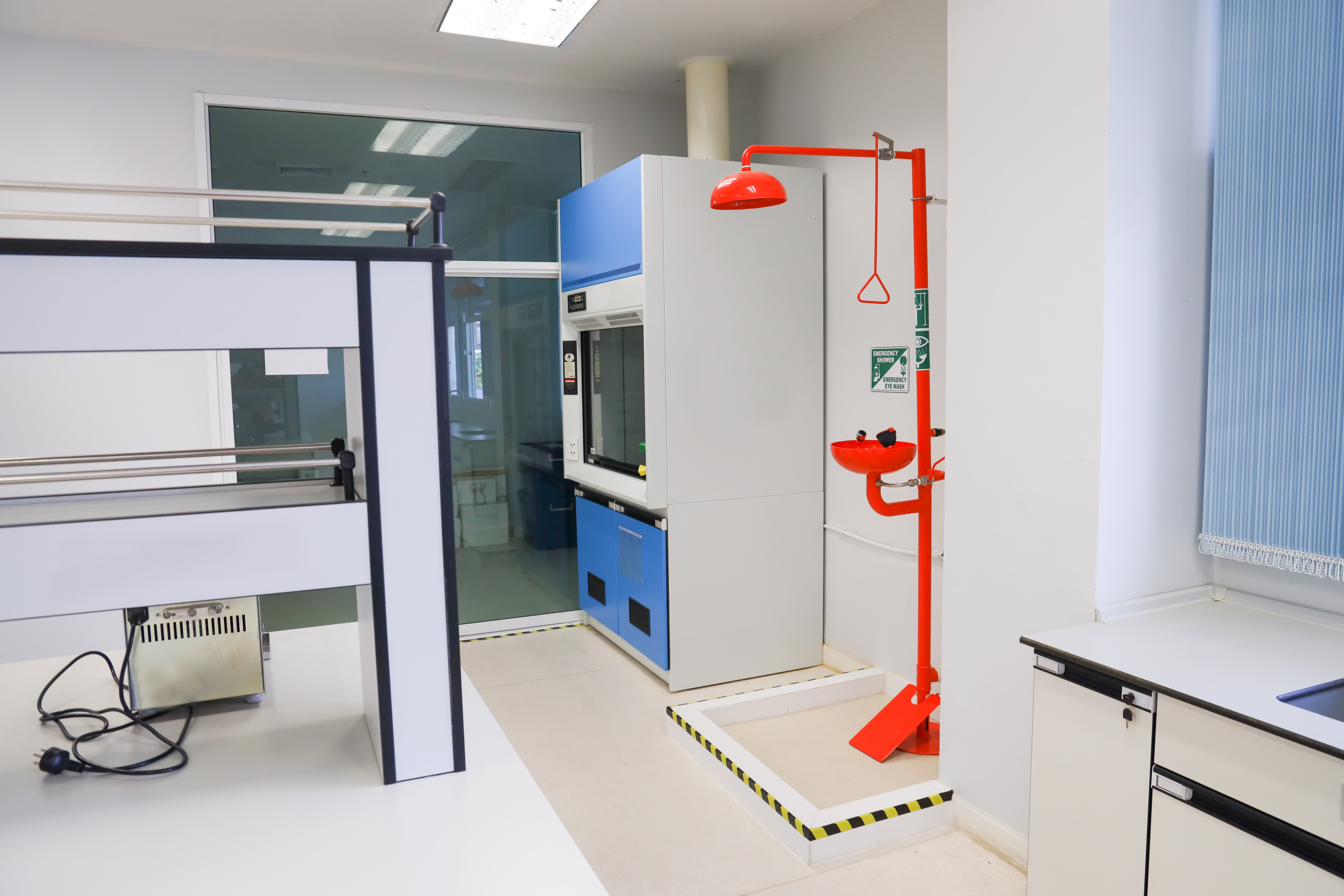
The standard also mandates that emergency stations must be:
- Located within a short distance of hazard—typically no more than 10 seconds walking time, or ~55 feet
- Installed on the same level as the hazard without obstacles
- Able to deliver flushing fluid that is tepid (i.e., approximately 16 °C to 38 °C or 60 °F to 100 °F, so that the injured person can stay under the flow for the required 15 minutes without hypothermia or shock
If the water supply is shared, undersized, or subject to pressure drops, these other criteria (proximity, temperature, uninterrupted flow) can be compromised, even if the shower or eyewash looks compliant on paper.
Consequences of Poor Pressure
When systems don’t meet these requirements, the results may include:
- Delayed or incomplete flushing of contaminants, increasing the risk of chemical burns, vision damage, or systemic absorption of chemicals
- Potential non-compliance with OSHA’s 29CFR 1910.151(c): “Where the eyes or body of any person may be exposed to injurious corrosive materials, suitable facilities for quick drenching or flushing of the eyes and body shall be provided within the work area for immediate emergency use.”
- Legal and financial exposure for the employer, and, most importantly, a failure or protective infrastructure when it matters most
Monitoring and Maintaining Best Practices
Even the best-designed emergency shower or eyewash station can fail to protect workers if it isn’t maintained and tested properly. ANSI/ISEA Z358.1-2014 sets clear expectations for inspection, activation, and maintenance to ensure these devices remain ready for immediate use at all times.
Weekly Activation and Annual Inspection
The standard requires that plumbed emergency fixtures be activated weekly to verify proper operation and flush any sediment or stagnant water from the supply line. This brief activation helps confirm that the valve fully opens in one second or less and that the flow remains steady and uniform throughout operation.
In addition, a comprehensive annual inspection is required to confirm ongoing compliance with all performance criteria, including:
- Flow rate and spray pattern
- Supply pressure and water temperature
- Accessibility (clear path within 10 seconds of the hazard, same elevation, no obstructions)
- Corrosion, leaks, and signage condition
Maintaining accurate inspection records is critical—not only for OSHA compliance, but also for liability protection and facility auditing.
Pressure and Flow Verification
During activation or annual testing, technicians should measure static and dynamic pressure at the fixture inlet. Low readings often indicate upstream restrictions such as clogged filters, corroded valves, or undersized piping. ANSI does not prescribe a fixed pressure number, but adequate supply must exist to sustain the minimum flow for 15 minutes.
In large or complex facilities, pressure can fluctuate significantly depending on other equipment loads. That makes continuous pressure monitoring highly beneficial. Sensors or transmitters placed in supply lines can provide real-time verification that each emergency fixture will operate at design performance whenever activated.
Temperature Control
ANSI defines “tepid” water as between 16 °C (60 °F) and 38 °C (100 °F). Water that is too cold can cause hypothermia and deter personnel from completing the 15-minute rinse; water that is too hot may exacerbate chemical burns. Mixing valves, thermostatic controls, and temperature sensors help maintain water within this safe range.
The Value of Preventive Monitoring
Facilities that integrate pressure, flow, and temperature instrumentation into their maintenance programs can automatically log compliance data, identify supply issues early, and minimize the risk of non-functioning equipment during an emergency. This proactive approach transforms safety shower and eyewash systems from passive infrastructure into verifiable, monitored protection assets.
Innovative Solutions from

Series V4 Flotect® Flow Switches
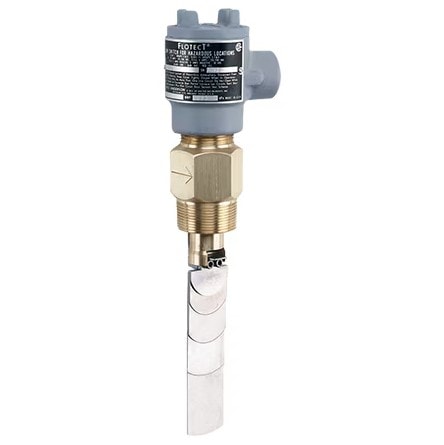
When an emergency shower or eyewash station is activated, it’s vital that facility staff and control systems know flow has begun. The Series V4 Flotect® Flow Switch provides that assurance with proven reliability in demanding environments.
Installed on the inlet water line, the V4 detects flow and sends a signal to alarms, indicator lights, or building systems—verifying proper activation and supporting safety compliance. Its magnetically actuated design uses a free-swinging vane to trigger a snap switch through a sealed metal body, eliminating bellows, springs, and seals that often fail. This simple, rugged mechanism ensures long service life with leak-proof operation.
With NEMA 4 weatherproof and explosion-proof models available, the Series V4 suits a wide range of industrial installations (pipe sizes 38 mm and larger (1½ in and up)).
Applications:
- Verify flow to emergency showers and eyewash stations
- Protect pumps and motors from low-flow or no-flow
- Control sequential or auxiliary pump operation
- Trigger alarms or system shutdowns when flow is lost
Series V6 Flotect® Flow Switch
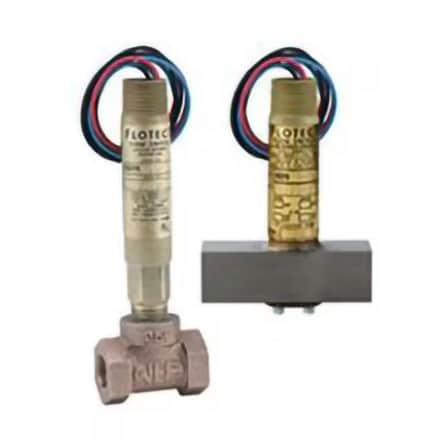
For applications requiring reliable flow detection in smaller pipelines, the Series V6 Flotect® Flow Switch provides compact, durable performance. It’s engineered to monitor liquid, gas, or air flow and is ideal for confirming activation in emergency showers and eyewash stations. Installed on the inlet line, the V6 can signal an alarm or control system the moment flow begins—verifying system readiness and operator response.
The V6 features a magnetically actuated switching mechanism housed in a leak-proof, machined metal body. With no bellows or springs to fail, it ensures long service life even in harsh environments. Available in weatherproof NEMA 4 and explosion-proof models, it fits pipelines from 13 to 50 mm (½ to 2 in), with adapters for smaller sizes.
Applications:
- Detect flow in emergency showers and eyewash stations
- Protect pumps and motors from low or no flow
- Control sequential or auxiliary pump systems
- Trigger alarms or shutdowns during flow interruption
